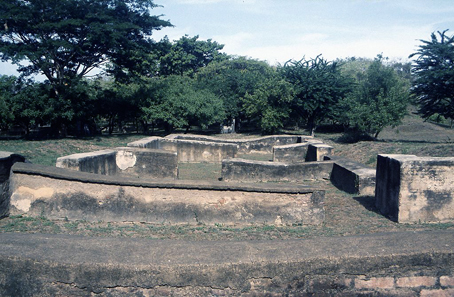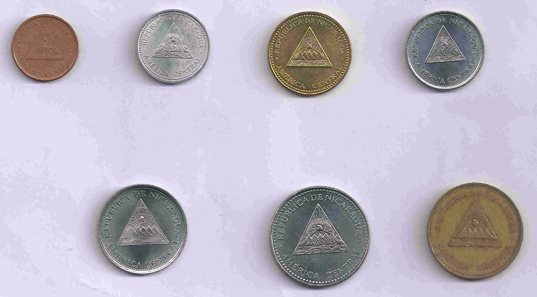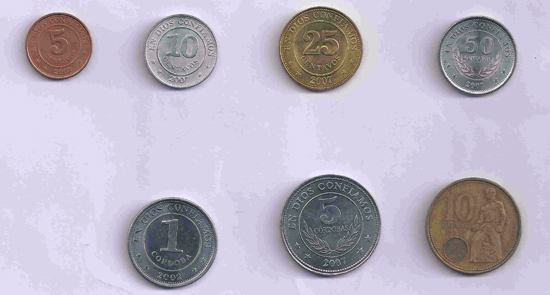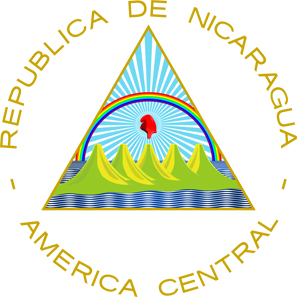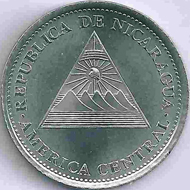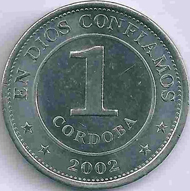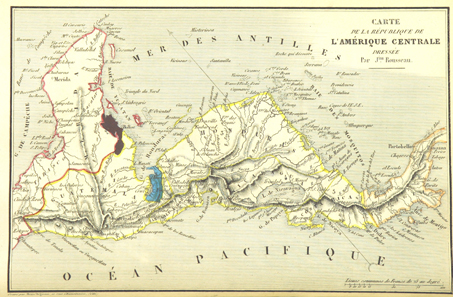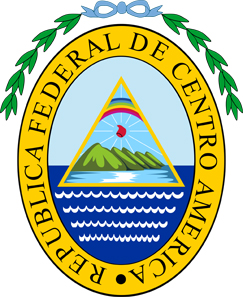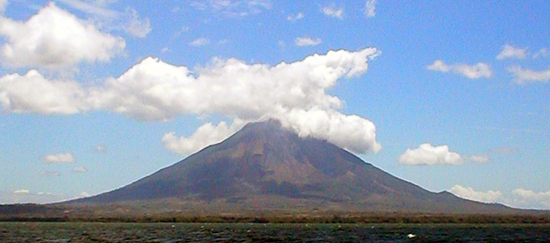translated by Annika Backe
‘In God we trust’, it says on every American dollar. Some people think that this belief in God has long been replaced by the faith in the power of the dollar. In Nicaragua, at any rate, several attempts have been made to peg the country’s currency to the U.S. dollar. All these attempts failed. But, at least, the motto of the dollar graces all of Nicaragua’s coins, down to the smallest denomination: ‘En Dios Confiamos’ – In God we trust.
This 1924 stamp features the national founder and titular saint of the national currency, Francisco Hernández de Córdoba.
Foundation of the state of Nicaragua
Córdoba oro, NIO in short, is the name of the currency of Nicaragua. It’s divided into 100 centavos and got its name from the man who is considered founder of the state of Nicaragua, Francisco Hernández de Córdoba. This Córdoba was a Spanish officer. His commander Pedrarias Dávila, who had been appointed Governor of Panama in 1514, sent him to the Pacific coast. In what is today Nicaragua, Córdoba founded Granada and Léon, two cities that are still important. He probably established himself as a kind of local ruler there. Anyway, soon his commander suspected him of mutiny. Dávila sent a small fleet that captured Córdoba. Held in high esteem in Nicaragua, the Spanish was decapitated in Léon, the city he had founded himself.
Excavated foundation walls still bear witness to the Léon of past times. Photo: Helmut Haefner / CC BY-SA 3.0
There was a sequel to this. The old Léon proper was completely buried when a volcano erupted in 1609. As a kind of Baroque Pompeii, it serves as an excavation site for modern archaeologists. In 2000, they unearthed the remains of decapitated Córdoba, who is revered as a kind of national hero in Nicaragua.
In 1912, Nicaragua introduced its new currency, the córdoba oro, which is in use until the present day.
Córdoba and Centavo
Let’s talk currency again. The córdoba was introduced on March 20, 1912 – for Nicaragua a year to remember. On May 9, 1911, the accountant Adolfo Díaz was elected President of the country. To create a new, stable currency, he introduced the córdoba for which he took so many loans with U.S. banks that he was forced to leave direct control of the Nicaraguan customs revenues, as security, to the U.S. government. Of course there was a strong resistance to this close connection between Nicaragua and the U.S. But the United States sent their marines, who landed in Nicaragua on August 14, 1912, and occupied the largest cities in the country. They remained there until 1933, protected the conservative government and made sure that American interests were safeguarded.
The coat of arms of Nicaragua. Source: C records.
The coat of arms of Nicaragua
Every circulating coin of Nicaragua shows the country’s coat of arms. It features a green mountain chain consisting of five volcanoes in the middle, amidst two blue sees. There is a red Phrygian cap above, surrounded by silver rays of light. Above all, we see a rainbow.
Like this 1-córdoba piece, all coins of Nicaragua feature the country’s coat of arms, the mountain chain with the five volcanoes.
It gets real exciting when you look at the transcription. As expected, it reads REPÚBLICA DE NICARAGUA. Below, however, we read AMERICA CENTRAL. Thus this coat of arms still refers to a significant episode in the history of Central America, a time when Guatemala, Honduras, El Salvador, Nicaragua, and Costa Rica formed a Federal Republic.
Historical map with the Republic of Central America, ca. 1840.
The United Provinces of Central America
On February 24, 1821, Mexico declared its independence from Spain. Other former Spanish provinces followed. They united under a joint government of the Central American states. Over the next years, Guatemala, El Salvador, Honduras, Nicaragua, Costa Rica, and Los Altos became members of this union, too.
The coat of arms of the United States of Central America. Source: Huhsunqu / CC BY-SA 2.5
Trade and freedom
At that time, liberal forces placed great hopes in the new confederation. Trade and freedom, these ideals were expressed both in the flag and the coat of arms. The flag featured a white stripe between two blue ones, symbolizing the land between the Atlantic Ocean and the Pacific Ocean. The coat of arms adopted this image and enriched it with the French Revolution liberty cap.
But day-to-day politics soon crushed the hope. Mexico developed very old-fashioned expansionist cravings. The provinces faced Mexican power claims increasingly often. Bureaucracy proved ineffective. Poverty and political instability resulted in a number of upheavals that held up the long-planned construction of the Panama Canal several times.
The individual states believed that decentralization could guarantee a more efficient use of resources. Thus, Nicaragua was the first country to leave the confederation in 1838. Honduras and Costa Rica were next. In 1840, the union dissolved once and for all.
Since then, the states of Central America have repeatedly tried to establish a closer connection, but none of these attempts proved successful in the long run. It’s their common history, though, that makes the countries feel connected after all. Some of the flags and the coat of arms of these countries still reflect the common past.
Volcanos, such as Concepción, and coasts are characteristic elements of the landscape of Nicaragua. Photo: Adrian Sampson / CC BY 2.0
And today?
Today, Nicaragua ranges among the world’s poorest countries. More than 50% of the population is said to live below the poverty line. Natural catastrophes, such as Hurricane Mitch, repeatedly ravage the country and eliminate the small steps towards progress.
It’s a political lesson how the self-interest of different groups have turned a promising country into a poverty house. Their poverty forces the residents of this house to willingly support every politician who promises them at least some economic growth.
Latest news on Nicaragua can be found at Today Nicaragua.
Tourists in particular will find practical information and suggestions on Lonelyplanet.






